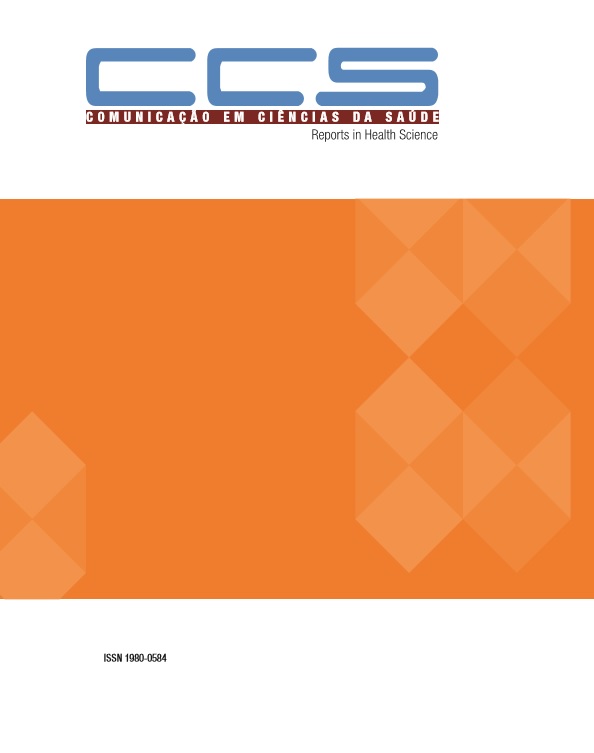Rhabdomyolysis after the use of tranexamic acid in a patient with hereditary angioedema
DOI:
https://doi.org/10.51723/ccs.v30i03.456Keywords:
Hereditary angioedema, Tranexamic acid, RhabdomyolysisAbstract
The hereditary angioedema, a genetic disorder with exacerbated bradykinin production and generalized edema, has different symptoms that arise without any causal factor. Treatment consists of the use of rescue medications during crises and short- and long-term prophylaxis. Objective: to report the case of a patient treated with tranexamic acid, an antifibrinolytic agent, who had elevated urea, creatinine and creatine phosphokinase, receiving the diagnosis of acute kidney injury by rhabdomyolysis. After discontinuing the drug, kidney function improved and the enzyme decreased. Conclusion: rhabdomyolysis is an effect described with the use of epsilon-aminocaproic acid, but not with tranexamic acid.
Downloads
References
Ferraro MF, Ferriani MPL, França AT, Fusaro G, Garcia JFB, Komninakis S, et al. Diretrizes brasileiras para o diagnóstico e tratamento do angioedema hereditário – 2017. Arq Asma, Alerg e Imunol. 2017;1:23–48.
Bork K, Meng G, Staubach P, Hardt J. Hereditary Angioedema : New Findings Concerning Symptoms , Affected Organs , and Course. Am J Med. 2006;119:267–74.
Kanani A, Betschel SD, Warrington R. Urticaria and angioedema. Allergy, Asthma Clin Immunol [Internet]. 2018;14(s2):1–13. Available from: https://doi.org/10.1186/s13223-018-0288-z
Lumry WR. Current and Emerging Therapies to Prevent Hereditary Angioedema Attacks. Am J Manag Care. 2017;24(14):299–307.
Maurer M, Maferl M, Ansotegui I, Aygoren-Pursun E, Betschel S, Bork K, et al. The international WAO / EAACI guideline for the management of hereditary angioedema — The 2017 revision and update. Eur J Allergy Clin Immunol. 2018;73(December 2017):1575–96.
Martins S, Salgado M, Raposo F, Pinto D, Martinho I, Araújo R. Angioedema recorrente – caso clínico. Rev Pediatr do Cent Hosp do Porto. 2014;XXIII(1):21–4.
Valle SOR, França AT, Campos RA, Grumach AS. Angioedema hereditário. Rev bras alerg imunopatol. 2010;33(3):80–7.
Cabral GG, Monice LM, Machado LRD, Caldeira LML, Silva LR e, Couto H de A. Insuficiência renal aguda devido à rabdomiólise. Acta Biomed Bras. 2012;3(2):42–7.
Dunn CJ, Goa KL. A Review of its Use in Surgery and Other Indications. ADIS DRUG Eval. 1999;57(6):1005–32.
Neto MP, Gonçalves RV, Machado CJ, Resende V. Fatores associados à variação da creatina fosfoquinase (CPK) em pacientes vítimas de trauma, submetidos à “Onda Vermelha”, com evolução à rabdomiólise. Rev Col Bras Cir. 2018;45(2):1–9.
Downloads
Published
Issue
Section
License
Declaro para os devidos fins que o artigo que estou submetendo representa um trabalho original e nunca foi publicado total ou parcialmente, e que se alguma de suas partes foi publicada possuímos autorização expressa para a publicação no periódico Comunicação em Ciências da Saúde (CCS). Esse artigo não foi enviado a outro periódico e não o será enquanto estiver sendo considerada sua publicação; caso venha a ser aceito não será publicado em outro periódico; e não contém material difamatório ou ilegal sob nenhuma forma, não viola a intimidade de terceiros, nem infringe direitos protegidos.
Eu e demais autores desse trabalho certificamos por meio desta declaração que:
- Concordamos com as normas editoriais e com o processo de revisão da CCS;
- Aceitamos a responsabilidade pela conduta desse estudo e pela análise e interpretação dos dados;
- Cooperaremos, sempre que solicitado, na obtenção e fornecimento de dados sobre os quais o manuscrito está baseado, para exame dos avaliadores;
- Não estão sendo omitidos quaisquer ligações ou acordos de financiamento entre os autores e companhias ou pessoas que possam ter interesse no material abordado no artigo;
- Não estão sendo excluídos ou omitidos deste artigo autores ou instituições participantes;
- Possuímos permissão para uso de figuras e tabelas publicadas em outras fontes;
- Possuímos permissão das pessoas e instituições citadas nos agradecimentos;
- O autor correspondente autoriza a publicação do endereço informado e e-mail do(s) autor(es) junto com o artigo;
- Assumimos a responsabilidade pela entrega de documentos verídicos;
- Autorizamos a publicação do referido artigo no periódico Comunicação em Ciências da Saúde, segundo critérios próprios e em número e volume a serem definidos pelo editor do periódico;
- Nos comprometemos a atender os prazos estipulados pelos editores do periódico Comunicação em Ciências da saúde;
- Estamos cientes de que a não manifestação no prazo de dois dias da revisão da diagramação, recebida por e-mail, será considerado aprovado para publicação.








